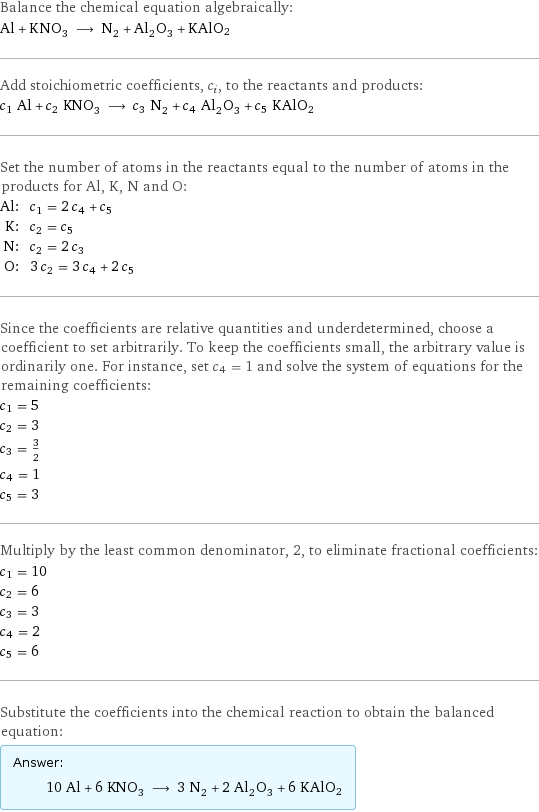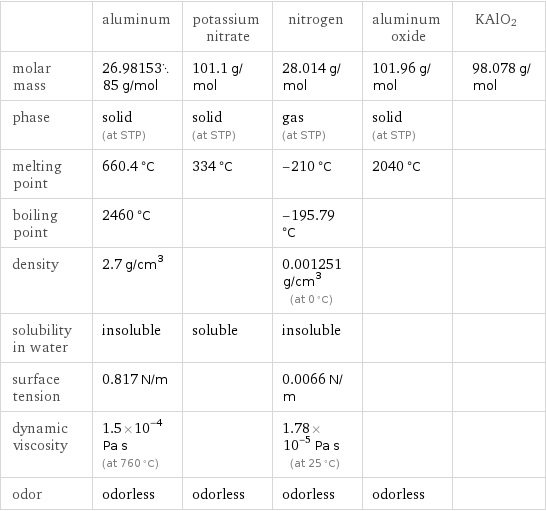Input interpretation

Al aluminum + KNO_3 potassium nitrate ⟶ N_2 nitrogen + Al_2O_3 aluminum oxide + KAlO2
Balanced equation

Balance the chemical equation algebraically: Al + KNO_3 ⟶ N_2 + Al_2O_3 + KAlO2 Add stoichiometric coefficients, c_i, to the reactants and products: c_1 Al + c_2 KNO_3 ⟶ c_3 N_2 + c_4 Al_2O_3 + c_5 KAlO2 Set the number of atoms in the reactants equal to the number of atoms in the products for Al, K, N and O: Al: | c_1 = 2 c_4 + c_5 K: | c_2 = c_5 N: | c_2 = 2 c_3 O: | 3 c_2 = 3 c_4 + 2 c_5 Since the coefficients are relative quantities and underdetermined, choose a coefficient to set arbitrarily. To keep the coefficients small, the arbitrary value is ordinarily one. For instance, set c_4 = 1 and solve the system of equations for the remaining coefficients: c_1 = 5 c_2 = 3 c_3 = 3/2 c_4 = 1 c_5 = 3 Multiply by the least common denominator, 2, to eliminate fractional coefficients: c_1 = 10 c_2 = 6 c_3 = 3 c_4 = 2 c_5 = 6 Substitute the coefficients into the chemical reaction to obtain the balanced equation: Answer: | | 10 Al + 6 KNO_3 ⟶ 3 N_2 + 2 Al_2O_3 + 6 KAlO2
Structures

+ ⟶ + + KAlO2
Names

aluminum + potassium nitrate ⟶ nitrogen + aluminum oxide + KAlO2
Equilibrium constant
![Construct the equilibrium constant, K, expression for: Al + KNO_3 ⟶ N_2 + Al_2O_3 + KAlO2 Plan: • Balance the chemical equation. • Determine the stoichiometric numbers. • Assemble the activity expression for each chemical species. • Use the activity expressions to build the equilibrium constant expression. Write the balanced chemical equation: 10 Al + 6 KNO_3 ⟶ 3 N_2 + 2 Al_2O_3 + 6 KAlO2 Assign stoichiometric numbers, ν_i, using the stoichiometric coefficients, c_i, from the balanced chemical equation in the following manner: ν_i = -c_i for reactants and ν_i = c_i for products: chemical species | c_i | ν_i Al | 10 | -10 KNO_3 | 6 | -6 N_2 | 3 | 3 Al_2O_3 | 2 | 2 KAlO2 | 6 | 6 Assemble the activity expressions accounting for the state of matter and ν_i: chemical species | c_i | ν_i | activity expression Al | 10 | -10 | ([Al])^(-10) KNO_3 | 6 | -6 | ([KNO3])^(-6) N_2 | 3 | 3 | ([N2])^3 Al_2O_3 | 2 | 2 | ([Al2O3])^2 KAlO2 | 6 | 6 | ([KAlO2])^6 The equilibrium constant symbol in the concentration basis is: K_c Mulitply the activity expressions to arrive at the K_c expression: Answer: | | K_c = ([Al])^(-10) ([KNO3])^(-6) ([N2])^3 ([Al2O3])^2 ([KAlO2])^6 = (([N2])^3 ([Al2O3])^2 ([KAlO2])^6)/(([Al])^10 ([KNO3])^6)](../image_source/8b060194b5bc6673dacd47daf8e06f9a.png)
Construct the equilibrium constant, K, expression for: Al + KNO_3 ⟶ N_2 + Al_2O_3 + KAlO2 Plan: • Balance the chemical equation. • Determine the stoichiometric numbers. • Assemble the activity expression for each chemical species. • Use the activity expressions to build the equilibrium constant expression. Write the balanced chemical equation: 10 Al + 6 KNO_3 ⟶ 3 N_2 + 2 Al_2O_3 + 6 KAlO2 Assign stoichiometric numbers, ν_i, using the stoichiometric coefficients, c_i, from the balanced chemical equation in the following manner: ν_i = -c_i for reactants and ν_i = c_i for products: chemical species | c_i | ν_i Al | 10 | -10 KNO_3 | 6 | -6 N_2 | 3 | 3 Al_2O_3 | 2 | 2 KAlO2 | 6 | 6 Assemble the activity expressions accounting for the state of matter and ν_i: chemical species | c_i | ν_i | activity expression Al | 10 | -10 | ([Al])^(-10) KNO_3 | 6 | -6 | ([KNO3])^(-6) N_2 | 3 | 3 | ([N2])^3 Al_2O_3 | 2 | 2 | ([Al2O3])^2 KAlO2 | 6 | 6 | ([KAlO2])^6 The equilibrium constant symbol in the concentration basis is: K_c Mulitply the activity expressions to arrive at the K_c expression: Answer: | | K_c = ([Al])^(-10) ([KNO3])^(-6) ([N2])^3 ([Al2O3])^2 ([KAlO2])^6 = (([N2])^3 ([Al2O3])^2 ([KAlO2])^6)/(([Al])^10 ([KNO3])^6)
Rate of reaction
![Construct the rate of reaction expression for: Al + KNO_3 ⟶ N_2 + Al_2O_3 + KAlO2 Plan: • Balance the chemical equation. • Determine the stoichiometric numbers. • Assemble the rate term for each chemical species. • Write the rate of reaction expression. Write the balanced chemical equation: 10 Al + 6 KNO_3 ⟶ 3 N_2 + 2 Al_2O_3 + 6 KAlO2 Assign stoichiometric numbers, ν_i, using the stoichiometric coefficients, c_i, from the balanced chemical equation in the following manner: ν_i = -c_i for reactants and ν_i = c_i for products: chemical species | c_i | ν_i Al | 10 | -10 KNO_3 | 6 | -6 N_2 | 3 | 3 Al_2O_3 | 2 | 2 KAlO2 | 6 | 6 The rate term for each chemical species, B_i, is 1/ν_i(Δ[B_i])/(Δt) where [B_i] is the amount concentration and t is time: chemical species | c_i | ν_i | rate term Al | 10 | -10 | -1/10 (Δ[Al])/(Δt) KNO_3 | 6 | -6 | -1/6 (Δ[KNO3])/(Δt) N_2 | 3 | 3 | 1/3 (Δ[N2])/(Δt) Al_2O_3 | 2 | 2 | 1/2 (Δ[Al2O3])/(Δt) KAlO2 | 6 | 6 | 1/6 (Δ[KAlO2])/(Δt) (for infinitesimal rate of change, replace Δ with d) Set the rate terms equal to each other to arrive at the rate expression: Answer: | | rate = -1/10 (Δ[Al])/(Δt) = -1/6 (Δ[KNO3])/(Δt) = 1/3 (Δ[N2])/(Δt) = 1/2 (Δ[Al2O3])/(Δt) = 1/6 (Δ[KAlO2])/(Δt) (assuming constant volume and no accumulation of intermediates or side products)](../image_source/6a38ef7f921245eec0bc46188c9d39f7.png)
Construct the rate of reaction expression for: Al + KNO_3 ⟶ N_2 + Al_2O_3 + KAlO2 Plan: • Balance the chemical equation. • Determine the stoichiometric numbers. • Assemble the rate term for each chemical species. • Write the rate of reaction expression. Write the balanced chemical equation: 10 Al + 6 KNO_3 ⟶ 3 N_2 + 2 Al_2O_3 + 6 KAlO2 Assign stoichiometric numbers, ν_i, using the stoichiometric coefficients, c_i, from the balanced chemical equation in the following manner: ν_i = -c_i for reactants and ν_i = c_i for products: chemical species | c_i | ν_i Al | 10 | -10 KNO_3 | 6 | -6 N_2 | 3 | 3 Al_2O_3 | 2 | 2 KAlO2 | 6 | 6 The rate term for each chemical species, B_i, is 1/ν_i(Δ[B_i])/(Δt) where [B_i] is the amount concentration and t is time: chemical species | c_i | ν_i | rate term Al | 10 | -10 | -1/10 (Δ[Al])/(Δt) KNO_3 | 6 | -6 | -1/6 (Δ[KNO3])/(Δt) N_2 | 3 | 3 | 1/3 (Δ[N2])/(Δt) Al_2O_3 | 2 | 2 | 1/2 (Δ[Al2O3])/(Δt) KAlO2 | 6 | 6 | 1/6 (Δ[KAlO2])/(Δt) (for infinitesimal rate of change, replace Δ with d) Set the rate terms equal to each other to arrive at the rate expression: Answer: | | rate = -1/10 (Δ[Al])/(Δt) = -1/6 (Δ[KNO3])/(Δt) = 1/3 (Δ[N2])/(Δt) = 1/2 (Δ[Al2O3])/(Δt) = 1/6 (Δ[KAlO2])/(Δt) (assuming constant volume and no accumulation of intermediates or side products)
Chemical names and formulas

| aluminum | potassium nitrate | nitrogen | aluminum oxide | KAlO2 formula | Al | KNO_3 | N_2 | Al_2O_3 | KAlO2 Hill formula | Al | KNO_3 | N_2 | Al_2O_3 | AlKO2 name | aluminum | potassium nitrate | nitrogen | aluminum oxide | IUPAC name | aluminum | potassium nitrate | molecular nitrogen | dialuminum;oxygen(2-) |
Substance properties

| aluminum | potassium nitrate | nitrogen | aluminum oxide | KAlO2 molar mass | 26.9815385 g/mol | 101.1 g/mol | 28.014 g/mol | 101.96 g/mol | 98.078 g/mol phase | solid (at STP) | solid (at STP) | gas (at STP) | solid (at STP) | melting point | 660.4 °C | 334 °C | -210 °C | 2040 °C | boiling point | 2460 °C | | -195.79 °C | | density | 2.7 g/cm^3 | | 0.001251 g/cm^3 (at 0 °C) | | solubility in water | insoluble | soluble | insoluble | | surface tension | 0.817 N/m | | 0.0066 N/m | | dynamic viscosity | 1.5×10^-4 Pa s (at 760 °C) | | 1.78×10^-5 Pa s (at 25 °C) | | odor | odorless | odorless | odorless | odorless |
Units
